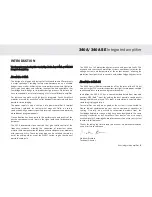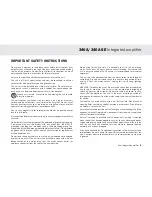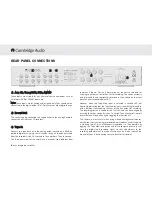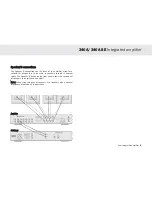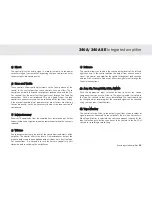
340A/340A SE
Integrated amplifier
Azur integrated amplifier
13
Remedy -
Ensure ventilation is not obstructed, and loudspeakers are not
of too low impedance. Switch the amplifier off for 15 minutes to cool
down if necessary.
3. DC offset protection
Indicator -
Amplifier will not operate; all input LEDs are flashing.
Description -
The DC offset protection system immediately isolates the
amplifier from the loudspeakers by positively opening an output relay, in
the unlikely event of an amplifier fault. Errors of either polarity on both
channels are detected.
Remedy -
This can sometimes be triggered by excessive mains noise etc;
if so switching the unit off and on again will reset it. If unit will not reset
then there is an amplifier fault that will require servicing. Switch the unit
off and contact your dealer.
4. Voltage clamping
When rapid transients are applied to reactive loads in extreme
circumstances, flyback pulses can be generated which are larger than
the amplifier supply rail voltages and have the potential to cause harm
to the output devices. The amplifier has a comprehensive voltage
clamping system that ensures that such pulses are safely absorbed by
the amplifier and no damage can result.
The Azur 340A/340A SE protection system comprises of:
1. Overload and Short-Circuit Protection
Indicator -
Output distorted and at unexpectedly low level.
Description -
The amplifier is fully protected against excessively low load
impedances. The overload and short-circuit protection systems
continuously monitor the voltage, current and temperature conditions of
each of the output devices, and comparing them with the defined Safe
Operating Area or SOA. This sophisticated system allows the protection
to act positively in case of genuine necessity, but without false
triggering.
Remedy -
Check loudspeaker impedance is not too low. Very often
loudspeakers of too low an impedance can be driven at low levels but
not high levels.
2. Over temperature detection
Indicator -
Output appears to cut out frequently, independently on the
two channels.
Description -
The instantaneous temperatures of the output devices of
the amplifier are continuously monitored to ensure that junction
temperatures do not get dangerously high. When an over temperature
condition occurs, the output is muted until the devices cool. The
operation is carefully controlled to minimise the exposure of the output
devices to wide temperature variations, which can impair reliability by
thermal cycling. This is accomplished by making the muting periods
relatively short, so the amplifier appears to be turning on and off. This
puts the least stress on the output devices.
PROTECTION SYSTEM



